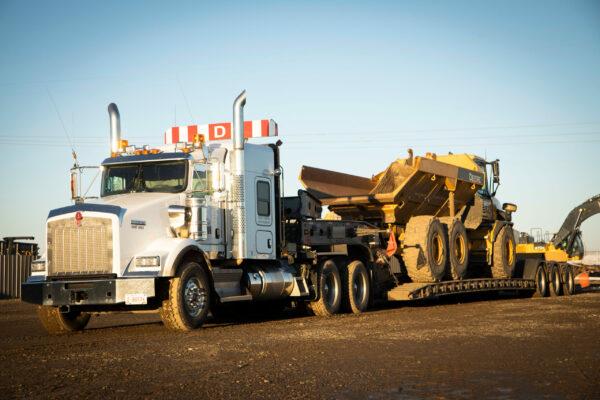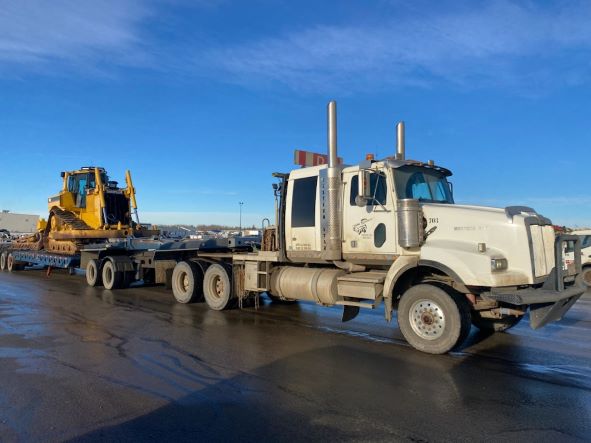When it comes to heavy-haul trucking, you have to do your best to expect the unexpected. On the road, there is always a possibility of potential challenges arising, such as weather, road construction, accidents, difficult terrain, or other obstacles. Because of this innate unpredictability, route planning for oversized transport is essential.
What Is Route Planning?
Route planning refers to any planning you and your driver do before hitting the road to ensure that all the correct factors have been considered in order to create the safest and most efficient route to the drop-off location. When you plan your route, you select roads that the load can safely drive on without breaking transport restrictions or causing accidents. The selected roads should also be relatively easy to navigate in undesirable weather and avoid construction if possible.
Different Equipment Requires Different Planning
Depending on the type of equipment you need to have shipped, your planning needs will vary. For example, a very tall and oversized load will require further research and planning. You need to make sure that the load can safely pass under any bridges and overpasses without causing accidents. Similar precautions need to be taken for other oversized loads, such as overly wide, long, tall, and heavy loads.
Increasing Safety and Efficiency
Preparing for hazards and obstacles during your route planning can help reduce delays during the actual haul and improve the chances of the load arriving on time. If you know the load needs to move through a separate state or province, you can check varying rules and regulations ahead of time. Being aware of hazards also allows for better preparedness which increases the job’s overall safety.
Varying Terrain
It is very important to adjust and focus your route planning based on the area(s) your shipment is travelling through. The vastness of North America means extremely variable terrain with an associated variety of hazards. Route planning needs to account for these variations by region.
Pacific Coastline
Stretching from California to Alaska, the Pacific Coastline of Canada and the United States features stretching coastal areas, forests, and mountains. Especially in British Columbia, Canada, the coastline is known for its winding roads and rainy weather. When planning routes on the Pacific Coastline, it is important to consider the hilly and uneven terrain.
Canadian Prairies and Midwestern States
Prairies are often flat stretches of land consisting of more grass than trees. The long, straight roads are easy to traverse, but keep in mind that the weather can be unpredictable and harsh. In the Canadian prairies and the Midwestern United States, winters are tough and cold, so engines need to be able to start in cold weather, and drivers need to be able to handle the winter conditions.
In other seasons, winds, storms and even tornados can also pose hazards during transport. Knowing which routes are riskier than others can help in safer route planning as well as staying informed on weather forecasts.
American Southwest
The American Southwest features various types of terrain, including mountains, rolling hills, flat plains, and desert-like conditions further south. Common hazards in this region include weather patterns, such as high-heat thunderstorms, areas at risk of landslides, and wildlife, along with general road hazards, such as traffic and road construction.
South and Southeastern United States
The weather in the Southern and Southeastern United States starts to get significantly warmer and more humid, inviting storms and, at certain times of the year, hurricanes. The terrain consists of forests and sometimes swampland, and the Appalachian mountains.
American East Coast
The Eastern coast has sprawling coastal plains leading to the Atlantic Ocean, but the roads can be quite hilly sometimes. The most common weather events one should expect to experience are multiple precipitation events, hurricanes, and possible storms. Erosion can also be an issue on roads in this region.
Ontario
Ontario is a very large province, and as such, its geography varies throughout. It is home to boreal forests, large plains, and, up north, cold tundras. The province usually experiences heavy snowfall in the winter, so consider the season you plan to ship your equipment in before booking a driver.
Oversized Transport Hauling in North America
To help you get your heavy-haul shipments through multiple states or provinces or across tough terrain or weather, Trusted Dispatch has the professional drivers and simplified process that you need. All of Trusted Dispatch’s drivers are vetted before being added to the network and are all experienced professionals. They will know how to plan properly and are experts at safety and efficiency on the road.
For all your heavy equipment transport needs, Trusted Dispatch is here to help. Get started today with your free, instant quote.





